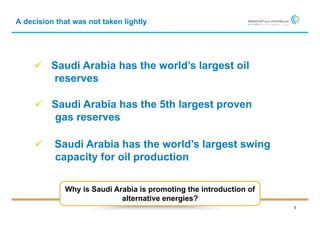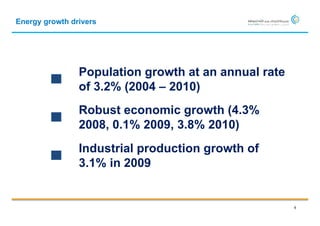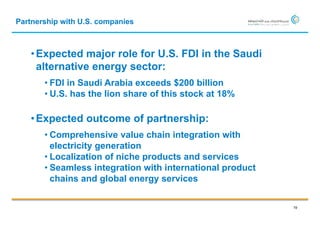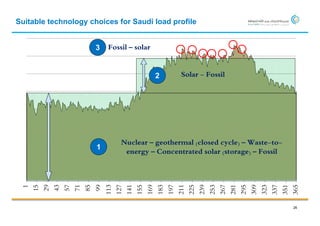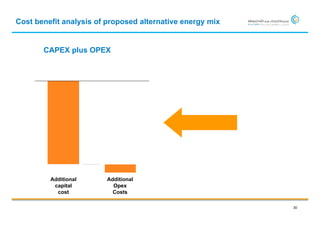Business Forum: Nuclear & Renewable Energy - Yamani
- 1. Nuclear and Renewable Energy Building Resources for the Future Dr. Hashim Yamani President King Abdullah City for Atomic and Renewable Energy (K.A.CARE)
- 2. Establishment of K.A.CARE Royal Order A/35 April 17, 2010 1
- 3. Royal Vision 2
- 4. K.A.CARE Mandate The City shall aim at contributing to the sustainable development in the Kingdom through utilization of science, research, and industries related to atomic and renewable energy for peaceful purposes in a way that leads to raising the standards of living and quality of life in the Kingdom 3
- 5. Towards energy sustainability The Kingdom of The Kingdom of Energy Sustainable Energy Towards greater sustainability A new energy mix to meet local needs as well as maintain leadership role in the global energy landscape 4
- 6. A decision that was not taken lightly Saudi Arabia has the world’s largest oil reserves Saudi Arabia has the 5th largest proven gas reserves Saudi Arabia has the world’s largest swing capacity for oil production Why is Saudi Arabia is promoting the introduction of alternative energies? 5
- 7. Energy growth drivers Population growth at an annual rate of 3.2% (2004 – 2010) Robust economic growth (4.3% 2008, 0.1% 2009, 3.8% 2010) Industrial production growth of 3.1% in 2009 6
- 8. Projected growth in electricity peak demand Electricity peak demand GW 120 70 45 2010 2020 2030 At current pace, energy peak demand is expected to exceed 120 GW by 2030 7
- 9. Growth in oil demand between 2007 and 2010 30 25 20 15 10 5 0 -5 -10 Saudi Arabia Asia North America Europe Middle East Latin America 8
- 10. Government allocation for water-related spending 50 9 45 8.5 40 8 35 30 7.5 (SR, bn) 25 7 20 (%) 6.5 15 6 10 5 5.5 0 5 2004 2005 2006 2007 2008 2009 2010 Water, electricity and infrastructure allocation Ratio to total state budget 9
- 11. SEC planned retiring capacity 140,000 120,000 100,000 The Gap By 80,000 2030 MW 60,000 40,000 20,000 Today’s Fuel Mix Extended to 2030 0 10
- 12. Forecast of energy demand growth 3.4* 8.3* MBOE MBOE 2010 2028 At current pace, domestic consumption of fossil fuels is expected to nearly triple by 2030 * Total local consumption (transportation, industry, electricity, etc) 11
- 13. Forecasted growth of alternative energy capacity worldwide 1,545 4.7 Growth 1,105 rate 533 2007 2020 2030 % Capacity 12% 17% 19% % of Installed Capacity 12
- 14. K.A.CARE vision The vision of K.A.CARE is to be: the driving force for making atomic and renewable energy an integral part of a national sustainable energy mix, by creating and leveraging the competitive advantages of relevant technologies for the social and economic development of the Kingdom of Saudi Arabia 13
- 15. Gradual introduction of renewable and atomic energy Nuclear Renewables Fossil TWh Alternative energy will gradually replace fossil based generation 14
- 16. Sustainable energy outlook for Saudi Arabia Wind/Other Ren Solar PV Solar CST Needed Capacity (MW) Nuclear New Required Fossil New Committed Existing Diesel Existing HFO Existing Crude Existing Gas 2010 2020 2030 2050 15
- 17. The mandate and responsibilities of K.A.CARE Policies & Execution Strategies Investment Regulatory & Business R&D & Investment Technology Relations Human Capacity K.A.CARE’s Mandate Facilities 16
- 18. R&D&T National legal Framework Pillars of sustainable development Value Chain National Economic Framework Sustainable Energy Mix National HR 17
- 19. New implementation paradigm 1. Long Term Commitment from all Partners Technology Education / Training 2. Contribution to GDP Creation: Job creation Value chain development Economic development spillovers Electricity generation 18
- 20. Partnership with U.S. companies • Expected major role for U.S. FDI in the Saudi alternative energy sector: • FDI in Saudi Arabia exceeds $200 billion • U.S. has the lion share of this stock at 18% • Expected outcome of partnership: • Comprehensive value chain integration with electricity generation • Localization of niche products and services • Seamless integration with international product chains and global energy services 19
- 21. Reaping the fruits of sustainable development Sustainable and efficient energy future for KSA Sustainable alternative “… use of alternative energy mix sustainable and reliable resources ... reduces dependency on hydrocarbon resources … and keep Balanced them as a source for execution income for a longer plans period of time...” 20
- 22. Bases for constructing recommended energy mix • Peak demand reduction from energy efficiency and conservation. • Liquid fuel (crude oil, diesel, and HFO) that will be saved by the proposed energy mix. • Generation related matters, such as: • load factors and load management • generation technologies and their practical limitations • Human capacity building potential. • International product chains and the Saudi role, in the alternative energy sector. • Local value chain 21
- 23. 1 15 29 43 57 60% 71 85 99 113 127 141 155 169 Seasonal peak variation in Saudi Arabia 183 197 211 225 239 253 267 281 295 309 100% 323 337 351 22 365
- 24. Typical daily demand profile variation for Saudi Arabia Demand profile GW for a summer day in August GW Demand profile for a winter day in January 11:00 13:00 15:00 17:00 19:00 21:00 23:00 1:00 3:00 5:00 7:00 9:00 23
- 25. GW 1 15 29 43 57 71 85 99 113 127 141 155 169 183 197 Annual day-night load variation for Saudi Arabia 211 225 239 253 Night 267 281 295 309 Day 323 337 351 24 365
- 26. Electricity load profile breakdown in Saudi Arabia 3 Daily summer peak load Additional summer load = 20% 2 of annual peak load 1 Average annual load = 65% of annual peak load 1 15 29 43 57 71 85 99 113 127 141 155 169 183 197 211 225 239 253 267 281 295 309 323 337 351 365 25
- 27. Suitable technology choices for Saudi load profile 3 Fossil – solar 2 Solar - Fossil Nuclear – geothermal (closed cycle) – Waste-to- 1 energy – Concentrated solar (storage) – Fossil 1 15 29 43 57 71 85 99 113 127 141 155 169 183 197 211 225 239 253 267 281 295 309 323 337 351 365 26
- 28. Criteria used to narrow down choices of energy mix Plausible energy mix criteria: • Sustainability • Economic viability • Technical feasibility • Enabling of further development Optimum energy mix criteria: • Must deliver the required capacity both cost-effectively and in a timely fashion 27
- 29. Illustrative example of a plausible energy mix Wind / Other Ren Solar PV Solar CST Nuclear New Additional Fossil Present Fossil Mix 28
- 30. Comprehensive stakeholder engagement Saudi Arabia: • Government agencies, regulator and utility • Private sector International: • Technology providers • Project developers • Utilities Activities: • Workshops, visits and meetings (hundreds) • Case studies (hundreds) 29
- 31. Cost benefit analysis of proposed alternative energy mix CAPEX plus OPEX Additional Additional capital Opex cost Costs 30
- 32. Cost benefit analysis of proposed alternative energy mix CAPEX plus OPEX plus revenue from oil saved Additional Additional Value of capital Opex oil cost Costs saved 31
- 33. Cost benefit analysis of proposed alternative energy mix CAPEX plus OPEX plus revenue from oil saved plus investment in value chain and human capacity Industry Additional Additional Value of and capital Opex oil human cost Costs saved capital 32
- 34. K.A.CARE commitment to developing alternative energy 1. Transparency 2. Safety and international best practices 3. Non-proliferation and highest standards of Safeguards 4. Localization of the nuclear and renewable value chain in Saudi Arabia 5. Transparent Incentives, Off Taking, and Funding Mechanism 33
- 35. Components of K.A.CARE City The KA-CARE city will include the following ▪ National Sustainable Energy Laboratory ▪ Industrial clusters ▪ Alternative energy farm ▪ Energy park ▪ Technical training institutions ▪ Technical incubators ▪ Commercial facilities ▪ Convention centers, exhibition halls and other public amenities ▪ KA-CARE headquarters and residential facilities ▪ Basic infrastructure 34
- 36. K.A.CARE City site characteristics 35
- 37. A global initiative 36
- 38. Virtual tour of the K.A.CARE City 37
- 39. First phase development plan for K.A.CARE City 3-5 year R&D focused develop- City infrastructure ment program for 8,000 to 10,000 requirements for Phase 1 residents (including 800 scientists) 1.5 GW of renewables 38
- 40. Summary 1. Saudi Arabia needs to add more than 80 GW of generation capacity by 2032. The additional capacity, anchored in energy conservation, would include nuclear, and renewable capacity. The investment required is in the hundreds of billion US dollars. 2. Saudi Arabia has been a favorable destination of U.S. FDI and exports, and we would certainly encourage this trend to grow in the renewable and nuclear energy sectors, as well as in energy conservation, conventional energy and energy support services. 39
- 41. Thank you





